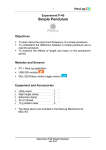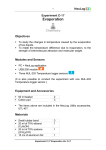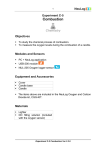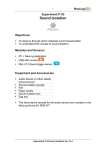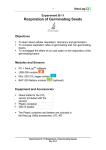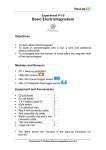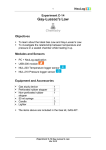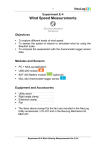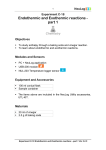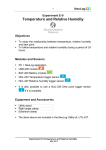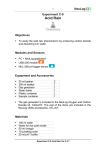Download Distillation – part 1 C-15
Transcript
1 Experiment C-15 Distillation - part 1 Objectives To learn about the three classical phases of matter, phase changes, and heating and cooling curves. To investigate the technique of distillation and to separate the components of a mixture by this means. Modules and Sensors PC + NeuLog application USB-200 module NUL-203 Temperature logger sensor Equipment and Accessories Utility stand Right angle clamp Extension clamp Still head Round bottom flask Condenser Receiver 50 ml beaker Alcohol lamp Safety goggles Boiling stone 1 1 1 1 1 1 1 2 1 4 The items above are included in the NeuLog Distillation kit, DST-KIT (four safety goggles are included in the NeuLog Utility accessories, UTL-KIT). Experiment C-15 Distillation – part 1 Ver 3.2.4 2 Materials 5 drops of food coloring 40 ml of 96 % Ethanol Lighter Experiment C-15 Distillation – part 1 Ver 3.2.4 3 Introduction The three classical phases of matter are solid, liquid and gas. Particles of a gas are well separated while particles of a liquid are closer together. Particles of a solid are tightly packed, and are structurally rigid. The following figure describes the different types of phase changes: A heating or a cooling curve shows the change in temperature of a sample as it is heated or cooled. Sloped regions correspond to temperature changes in one of the different states. Flat regions (constant temperature) correspond to phase changes (this will be discussed further on). Distillation is a method for purifying liquids and separating liquid mixtures. It is based on the fact that different substances have different boiling points (the temperature in which liquid changes into gas). It is commonly used in the lab, and it also has several commercial uses such as fractionation of crude oil into useful products and concentrating alcohol. The general principle of distillation is starting with a mixture of liquids with different boiling points, heating the mixture to the first boiling point, cool down the vapor and collect the condensed liquid. This liquid is enriched with the lower boiling point component. The liquid that is left behind is enriched with the higher boiling point component. In this experiment we will use a distillation kit with an ethanol and food coloring solution in order to observe the distillation process. Experiment C-15 Distillation – part 1 Ver 3.2.4 4 Procedure Experiment setup Caution: You will be working with an open flame. Make sure not to have any flammable material in the proximity of the experiment. Be very careful when working with high temperatures. It is recommended to wear personal protective equipment. Material Safety Data Sheets (MSDS) are available online. 1. Set up the experiment as shown in the picture below. C B A D E 2. Make sure you have a beaker with 10 ml of 96% ethanol with 5 drops of food coloring and 4 boiling stones. 3. Insert the side tube of the still head into the condenser adaptor and screw the black cap (the caps should be screwed tightly but carefully) (A). 4. Insert the other side of the condenser into the receiver and screw the black cap (B). Experiment C-15 Distillation – part 1 Ver 3.2.4 5 5. Insert the temperature sensor's probe in the still head through the hole in the top cap up to where the still head and the condenser meet. Screw this cap to hold the probe in place (C). 6. Install the assembled system on the utility stand, using the extension clamp (D). 7. Pour the colored ethanol into the round bottom flask and put the boiling stones inside as well. Insert the still head into it and screw the black cap (E). 8. Place a clean 50 ml beaker under the receiver, and a closed alcohol lamp filled with 30 ml of 96 % ethanol around 4 cm under the round bottom flask. 9. Make sure you also have a lighter. Experiment C-15 Distillation – part 1 Ver 3.2.4 6 Sensor setup 10. Connect the USB-200 module 11. Check that the temperature sensor USB-200 module. to the PC. is connected to the Note: The following application functions are explained in short. It is recommended to practice the NeuLog application functions (as described in the user manual) beforehand. 12. Run the NeuLog application and check that the temperature sensor is identified. Settings 13. Click on the On-line Experiment icon main icon bar. 14. Click on the Experiment Setup icon in the NeuLog and set the: Experiment duration to 10 minutes Sampling rate to 60 per minute Experiment C-15 Distillation – part 1 Ver 3.2.4 7 Testing and measurements 15. Open the alcohol lamp and pull out (using the handle) a little bit of wick. 16. Click on the Run Experiment icon measurement. 17. Make sure that there isn't any exposed ethanol near the working space. Very carefully light the alcohol lamp and adjust the flame so that it will be around 1 cm bellow the flask. 18. Turn off the alcohol lamp at the end of the measurement. If all the ethanol boils before the time is over, (only a little bit of food coloring with water should remain) stop the experiment. 19. Click on the Zoom Fit icon 20. Your graph should be similar to the following: to start the . The boiling point of ethanol (78.5ºC) 21. Save your graph. 22. After finishing the experiment loosen the cap before separating each part. 23. The measurement starts at room temperature, after lighting the alcohol lamp, the probe is heated by the flame. Experiment C-15 Distillation – part 1 Ver 3.2.4 8 After reaching 37º C there is a sharper rise in temperature, the ethanol heats up until the temperature reaches 78.5 ºC – the boiling point of ethanol, and remains constant throughout the boiling process. The reason that the temperature stays at 78.5 ºC is latent heat. Latent heat is the amount of energy absorbed or released by a substance during a change in its physical state without a change in temperature. The temperature was constant because heat was absorbed as latent heat of vaporization. Summary questions 1. Why didn't the food coloring (with water) vaporize and drip into the beaker? 2. What will happen if we use two solutions with the same boiling point for this experiment? 3. How does the strength of intermolecular forces affect the boiling point of a chemical substance? Give an example and explain. Experiment C-15 Distillation – part 1 Ver 3.2.4








